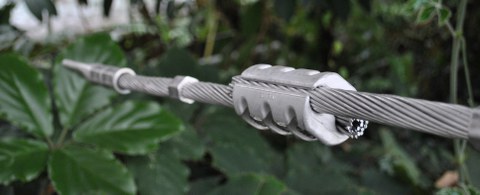Weitere Kooperationen
Vertical Farming – ein Pilotprojekt von UNU-FLORES und TU Dresden
Im Botanischen Garten steht seit dem Frühjahr 2025 ein hydroponischer Turm. Er gehört zu einem von UNU-Flores initiiertem Pilotprojekt. Dieses in Dresden ansässige Institut der UnIted Nations University forscht schwerpunktmäßig zur nachhaltigen Nutzung von Umweltressourcen. Der Turm wurde aufgebaut, um zu testen, wie Vertical Farming in der Praxis funktioniert. Ziel ist es herauszufinden, welche Gemüsesorten sich am besten für die Bedingungen und den Standort des Anbauturms eignen und unter welchen Umweltbedingungen sich ein gesundes und effizientes Pflanzenwachstum erreichen lässt. Vertical Farming ist eine innovative Anbaumethode, bei der Pflanzen auf, an oder in Gebäuden sowie an vertikalen Flächen oder (so wie hier) in Türmen kultiviert werden. Häufig kommen dabei platzsparende hydroponische oder aerponische Systeme ohne Erde zum Einsatz, bei denen nährstoffreiches Wasser die Wurzeln umspült. Diese Technik spart im Vergleich zur herkömmlichen Landwirtschaft erheblich Wasser und Fläche und ermöglicht eine ressourcenschonende Lebensmittelproduktion direkt in der Stadt – nah am Endverbraucher.
Mehr Informationen zum Projekt
BienenBrückenBauen - ein Projekt des Umweltzentrum Dresden e.V.
Auf dem Gelände des Botanischen Gartens wird 2025 eine Bestandserfassung von Wildbienen durch das Projekt BienenBrückenBauen des Umweltzentrums Dresden e.V. durchgeführt. Zwischen April und September untersuchen Projektmitarbeiter*innen, welche Wildbienenarten auf den Flächen vorhanden sind.
Die Erfassungen sollen dazu beitragen, eine möglichst vollständige Artenliste der Wildbienen im Stadtgebiet von Dresden zu erstellen. Mit dem Wissen, welche Arten in unserer Stadt vorkommen, können wildbienenfördernde Maßnahmen zielgerichteter geplant und umgesetzt werden. Das Projekt BienenBrückenBauen hat sich zum Ziel gesetzt, die Situation von Wildbienen im Stadtgebiet von Dresden zu verbessern. Auch für Bürger*innen der Stadt gibt es Beteiligungsmöglichkeiten: von Artenkennerkursen, Wildbienenberatung bis hin zum Pflanzen bienenfreundlicher Blühpflanzen auf dem eigenen Balkon oder im Garten.
Text: BienenBrückenBauen, Reinhild Müller Botanischer Garten

Auf Wildbienenexkursion im Botanischen Garten Dresden
Modellprojekt Integrales Wassermanagement
In dem seit 12/2019 laufenden Projekt erforscht ein Team aus den Fachbereichen Landschaftsarchitektur, Siedlungshydrologie, Meteorologie und Bauphysik die komplexen Prozesse einfacher Intensivdachbegrünungen. Auf einem Dach im Botanischen Garten wurden 21 einzeln erfassbare Versuchsflächen errichtet. Die Bewässerung der Dachflächen erfolgt durch Grauwasser aus dem Verwaltungsgebäude. Ziel ist es unter anderem, die Auswirkungen bewässerter einfacher Intensivbegrünung auf Bausubstanz und -klima, Wasserhaushalt, Umgebungsklima sowie Vitalität und Ästhetik der Pflanzung quantifizierbar zu machen.
Mehr Informationen zum Projekt
Forschungsprojekt „Schutzkomponenten zur Reduzierung solarer UV-Expositionen bei Arbeitnehmern im Freien“
Etwa drei Millionen Beschäftigte in Deutschland arbeiten überwiegend oder teilweise im Freien. Sie setzen sich dabei oft mehrere Stunden am Tag einer erhöhten UV-Belastung aus. Das hat Folgen: Sie tragen ein doppelt so hohes Risiko, einen Hauttumor auszubilden.
Die Bundesanstalt für Arbeitsschutz und Arbeitsmedizin (BAuA) sowie die Klinik und Poliklinik für Dermatologie der TU Dresden untersuchten in einem Forschungsprojekt verschiedene Schutzmaßnahmen auf ihre Wirksamkeit und Umsetzbarkeit. Hierzu wurden auch mehrere Langzeitmessungen und Tests zusammen mit den Mitarbeitern des Botanischen Gartens durchgeführt, die regelmäßig im Freien arbeiten. Die Ergebnisse der Studie liefern Handlungshilfen für Arbeitgeber und Beschäftigte.
Langzeitverhalten von elektrischen Kontakten im tropischen Klima

Wie verhalten sich technische Verbindungen im tropischen Klima? Versuche im Tropenhaus sollen neue Erkenntnisse dazu liefern.
Der weltweit zunehmende Bedarf an Energie und der Wandel in den Strukturen der Energieversorgung verändern die bestehenden Elektroenergiesysteme. Daraus entstehen neue Herausforderungen für Entwickler und Hersteller der Komponenten dieser Systeme, die einen erheblichen Forschungsbedarf generieren.
Mit der immer intensiveren Nutzung regenerativer Energiequellen weit entfernt von den zu versorgenden Ballungsgebieten in anderen Kontinenten sind Kenntnisse auch zum Langzeitverhalten von Verbindungen unter (aus europäischer Sicht) „extremem“ Klima erforderlich. In Dauerversuchen wird der Verbindungswiderstand typischer realer technischer Verbindungen unter sehr unterschiedlichen Umgebungsbedingungen teilweise bereits über drei Jahre beobachtet. Vergleichende Versuche wurden unter Wüsten- und Küstenbedingungen in Ägypten, im tropischen Regenwald Brasiliens, unter subpolaren Bedingungen im nördlichen Sibirien sowie im Tropenhaus des Botanischen Gartens in Dresden aufgebaut.
Quellen:
[1] S. Dreier, S. Großmann, G. Moustafa, D. Guiaraes dos Santos, B. Rocha und V. Macedo: Long term behaviour of stationary electrical connections in areas with harsh natural environmental conditions. CIGRÉ Science & Engineering Journal, 2015.
[2]M. Hering, S. Großmann: Komponenten zu Systemen verbinden - Aktuelle Herausforderungen. 14. Symposium Energieinnovation, 10.-12.02.2016, Graz/Austria
Text und Bilder: Sebastian Dreier
